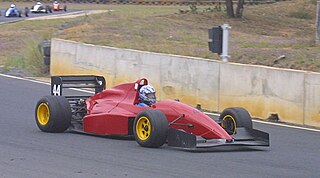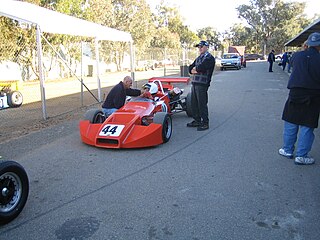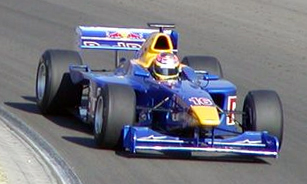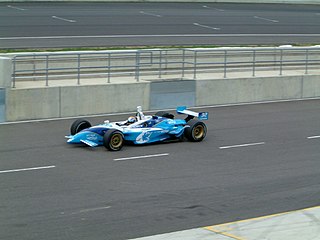Arthur Abrahams) is a semi-retired Australian race car driver. He won the 1987, 1991 and 1993 Australian Formula 2 Championships driving a Cheetah Mk8, Ransburg Cheetah and Reynard 913 respectively. he also won the Australian group C touring car endurance championship (1600cc) in 1984. He competed in International Sportscars in Europe and in American open wheel racing cars. He also competed in Formula Brabham/Holden for three years, debuting in 1994 and leaving the category in 1996. He was owner of the NRC International team in Formula Holden before running Dale Brede amongst others in V8 Supercar's Development Series. In 2001 Abrahams stepped away from the sport to focus on his and family business interests.
Adrian John Reynard is a businessman and commercial astronaut. He is the founder of Reynard Motorsport, which was a successful racing car manufacturer before it went bankrupt in 2002.

Formula Holden was an Australian open wheel racing category introduced in 1989.
Simon Wills is a former racing driver who currently runs a graphic design business.

Cheetah Racing Cars was a prolific Australian manufacturer of race cars. The cars were almost solely designed, engineered and constructed by Brian Shead in a small factory at the rear of his home in Mordialloc, a suburb of Melbourne, Australia.
The 1999 Australian Drivers' Championship was a CAMS sanctioned motor racing title open to drivers of Formula Holden racing cars. The winner of the championship, which was the 43rd Australian Drivers' Championship, was awarded the 1999 CAMS Gold Star. Due to a sponsorship arrangement with Holden, the championship was promoted as the "Holden Australian Drivers' Championship".

Formula 3000 (F3000) was a type of open wheel, single seater formula racing, occupying the tier immediately below Formula One and above Formula Three. It was so named because the cars were powered by 3.0 L engines.
The 2002 Australian Drivers' Championship was a CAMS sanctioned Australian motor racing title for drivers of Formula Holden racing cars with the 2002 CAMS Gold Star awarded to the winning driver. It was the 46th Australian Drivers' Championship.
The 1994 Australian Drivers' Championship was a CAMS sanctioned motor racing competition open to drivers of racing cars complying with CAMS Formula Brabham regulations. The championship winner was awarded the 1994 CAMS Gold Star as the Australian Champion Driver. It was the 38th running of the Australian Drivers' Championship and the sixth to feature the Formula Holden / Formula Brabham category which had been developed during 1988. The championship began on 17 April 1994 at Eastern Creek Raceway and ended on 28 August at Oran Park Raceway after six rounds.
The 1997 Australian Drivers' Championship was a motor racing competition open to drivers of racing cars complying with CAMS Formula Holden regulations. The championship winner was awarded the 1997 CAMS Gold Star as the Australian Drivers' Champion. It was the 41st running of the Australian Drivers' Championship, and the ninth to feature the Formula Holden category which had been developed during 1988. The championship began on 15 March 1997 at the Calder Park Raceway and ended on 3 August at Oran Park Raceway after seven rounds of a series which was promoted as the "Holden Australian Drivers Championship".
The 2003 Australian Drivers' Championship was a CAMS sanctioned national motor racing title for drivers of cars conforming to Formula 4000 regulations. The title was contested over a six-round, twelve race series which was promoted as the 2003 Holden Australian Drivers' Championship for the CAMS Gold Star. It was the 47th Australian Drivers' Championship.
The 2001 Australian Drivers' Championship was a CAMS sanctioned national motor racing title for drivers of cars conforming to Formula Holden regulations, with the winner awarded the 2001 CAMS Gold Star. This, the 45th Australian Drivers' Championship, was promoted as the 2001 Holden Australian Drivers' Championship.
The 2000 Australian Drivers' Championship was a CAMS sanctioned national motor racing title for drivers of cars conforming to Formula Holden regulations. The title was contested over an 8-round, 16 race series with the winner awarded the 2000 CAMS Gold Star. The championship, which was promoted as the 2000 Holden Australian Drivers' Championship, was the 44th Australian Drivers' Championship and the 12th to be contested with Formula Holden or Formula Brabham cars.
The 1998 Australian Drivers' Championship was a CAMS sanctioned Australian motor racing title for drivers of cars conforming to Formula Holden regulations. The title was contested over a six-round, twelve race series with the winner awarded the CAMS Gold Star. Officially the "Holden Australian Drivers' Championship for the CAMS Gold Star", it was the 42nd Australian Drivers' Championship.

Reynard Motorsport was the world's largest racing car manufacturer in the 1980s. Initially based at Bicester and latterly at Reynard Park, Brackley, England the company built successful cars in Formula Ford 1600, Formula Ford 2000, Formula Vauxhall Lotus, Formula Three, Formula 3000 and CART.

Birrana was the name of two motor racing organisations, both associated with South Australian racing driver and engineer Malcolm Ramsay. From 1971 to 1978 Birrana constructed a series of successful open-wheel racing cars under the Birrana name. It also constructed a Holden Kingswood HQ for Ramsay to compete in Group C Improved Production Touring Cars racing.
The McLaren M18 is an open-wheel Formula 5000 racing car designed and made by McLaren in 1971.
The Reynard 95D is an open-wheel formula race car, designed and developed by Malcolm Oastler, and constructed and built by Reynard Motorsport, for use in Formula 3000 categories, Formula Nippon, and Formula Holden racing series', in 1995.
The Reynard 91D is an open-wheel formula race car, designed and developed by Malcolm Oastler, and constructed and built by Reynard Motorsport, for both Formula 3000 and Formula Holden racing series, in 1991.

The Reynard 02I is an open-wheel racing car chassis designed and built by Reynard Racing Cars that competed in the 2002 IndyCar season. Development continued and its life was extended, and it saw competition in the Champ Car series, between 2003 and 2004.






